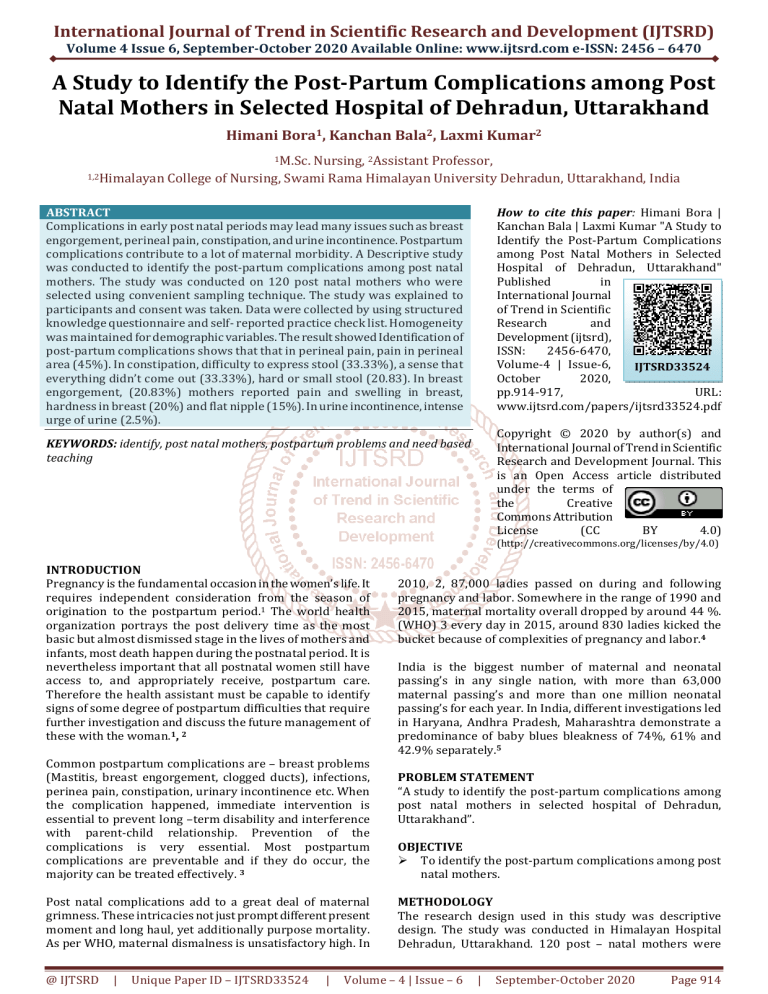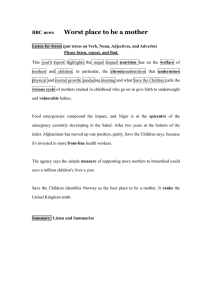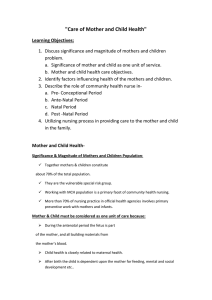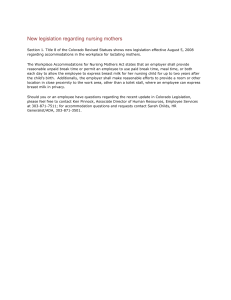
International Journal of Trend in Scientific Research and Development (IJTSRD)
Volume 4 Issue 6, September-October 2020 Available Online: www.ijtsrd.com e-ISSN: 2456 – 6470
A Study to Identify the Post-Partum Complications among Post
Natal Mothers in Selected Hospital of Dehradun, Uttarakhand
Himani Bora1, Kanchan Bala2, Laxmi Kumar2
1M.Sc.
Nursing, 2Assistant Professor,
1,2Himalayan College of Nursing, Swami Rama Himalayan University Dehradun, Uttarakhand, India
How to cite this paper: Himani Bora |
Kanchan Bala | Laxmi Kumar "A Study to
Identify the Post-Partum Complications
among Post Natal Mothers in Selected
Hospital of Dehradun, Uttarakhand"
Published
in
International Journal
of Trend in Scientific
Research
and
Development (ijtsrd),
ISSN:
2456-6470,
Volume-4 | Issue-6,
IJTSRD33524
October
2020,
pp.914-917,
URL:
www.ijtsrd.com/papers/ijtsrd33524.pdf
ABSTRACT
Complications in early post natal periods may lead many issues such as breast
engorgement, perineal pain, constipation, and urine incontinence. Postpartum
complications contribute to a lot of maternal morbidity. A Descriptive study
was conducted to identify the post-partum complications among post natal
mothers. The study was conducted on 120 post natal mothers who were
selected using convenient sampling technique. The study was explained to
participants and consent was taken. Data were collected by using structured
knowledge questionnaire and self- reported practice check list. Homogeneity
was maintained for demographic variables. The result showed Identification of
post-partum complications shows that that in perineal pain, pain in perineal
area (45%). In constipation, difficulty to express stool (33.33%), a sense that
everything didn’t come out (33.33%), hard or small stool (20.83). In breast
engorgement, (20.83%) mothers reported pain and swelling in breast,
hardness in breast (20%) and flat nipple (15%). In urine incontinence, intense
urge of urine (2.5%).
Copyright © 2020 by author(s) and
International Journal of Trend in Scientific
Research and Development Journal. This
is an Open Access article distributed
under the terms of
the
Creative
Commons Attribution
License
(CC
BY
4.0)
KEYWORDS: identify, post natal mothers, postpartum problems and need based
teaching
(http://creativecommons.org/licenses/by/4.0)
INTRODUCTION
Pregnancy is the fundamental occasion in the women’s life. It
requires independent consideration from the season of
origination to the postpartum period.1 The world health
organization portrays the post delivery time as the most
basic but almost dismissed stage in the lives of mothers and
infants, most death happen during the postnatal period. It is
nevertheless important that all postnatal women still have
access to, and appropriately receive, postpartum care.
Therefore the health assistant must be capable to identify
signs of some degree of postpartum difficulties that require
further investigation and discuss the future management of
these with the woman.1, 2
Common postpartum complications are – breast problems
(Mastitis, breast engorgement, clogged ducts), infections,
perinea pain, constipation, urinary incontinence etc. When
the complication happened, immediate intervention is
essential to prevent long –term disability and interference
with parent-child relationship. Prevention of the
complications is very essential. Most postpartum
complications are preventable and if they do occur, the
majority can be treated effectively. 3
Post natal complications add to a great deal of maternal
grimness. These intricacies not just prompt different present
moment and long haul, yet additionally purpose mortality.
As per WHO, maternal dismalness is unsatisfactory high. In
@ IJTSRD
|
Unique Paper ID – IJTSRD33524
|
2010, 2, 87,000 ladies passed on during and following
pregnancy and labor. Somewhere in the range of 1990 and
2015, maternal mortality overall dropped by around 44 %.
(WHO) 3 every day in 2015, around 830 ladies kicked the
bucket because of complexities of pregnancy and labor.4
India is the biggest number of maternal and neonatal
passing’s in any single nation, with more than 63,000
maternal passing’s and more than one million neonatal
passing’s for each year. In India, different investigations led
in Haryana, Andhra Pradesh, Maharashtra demonstrate a
predominance of baby blues bleakness of 74%, 61% and
42.9% separately.5
PROBLEM STATEMENT
“A study to identify the post-partum complications among
post natal mothers in selected hospital of Dehradun,
Uttarakhand”.
OBJECTIVE
To identify the post-partum complications among post
natal mothers.
METHODOLOGY
The research design used in this study was descriptive
design. The study was conducted in Himalayan Hospital
Dehradun, Uttarakhand. 120 post – natal mothers were
Volume – 4 | Issue – 6
|
September-October 2020
Page 914
International Journal of Trend in Scientific Research and Development (IJTSRD) @ www.ijtsrd.com eISSN: 2456-6470
selected by Convenient sampling technique. Data were
collected by demographic details. Assessment check list was
developed to identify the postpartum complications in post
natal mothers. the study was explained to participants and
written consent was taken. The data were collected with the
help of various tools consisting of –
Section A. Demographic variables: consist of age of
mothers, education of mothers, religion, occupation, monthly
income, area of living, type of family, dietary pattern,
duration of marriage, type of delivery, parity, number of
children, post natal day, previous information about
prevention of postpartum complications along with source
of data.
Section B. Assessment check list to assess the
postpartum complications among post natal mothers:
Assessment check list was developed to identify the
postpartum complications in post natal mothers. There were
total 13 problems included breast engorgement, urine
incontinence, constipation, perineal pain, urinary tract
infection, and perineal infection. One score was awarded for
each statement based on signs and symptoms present in post
natal mother. If there were no signs than it scored zero.
Presentation of the data
The data was entered in a master sheet, for tabulation and
statistical processing. The data was tabulated, analyzed and
the interpreted using descriptive and inferential statistical
methods. The data was analyzed and the interpretation was
drawn.
SECTION- A: This section deals with the distribution of
the study subjects based on their demographic variables
such as age of mothers, education of mothers, religion,
occupation, monthly income, area of living, type of family,
dietary pattern, duration of marriage, type of delivery,
parity, number of children, post natal day.
Table no 1-Frequency & percentage distribution of profile of the post natal mothers.
S. NO. Sample characteristics Frequency (f) Percentage %
Age (in years)
19 - 26
60
50%
1
27 – 33
54
45%
34 - 40
6
5%
EducationNo formal education
4
3.33%
2
Primary
4
3.33%
Secondary
51
42.51%
Above secondary
61
50.83%
Religion –
Hindu
104
86.66%
3
Muslim
12
10.01%
Sikh
4
3.33%
others
OccupationHome maker
114
95%
4
Self-employee
Gov. job
Private job
6
5%
Monthly income in Rs.
5000- 20000
95
79.17%
5
20001- 35000
20
16.67%
35001 – 50000
5
4.16%
Area of residence –
Rural
51
42.5%
6
Urban
63
52.5%
Semi urban
06
5%
Types of family –
Nuclear
67
55.84%
7
Joint
53
44.16%
Extended family
Dietary pattern –
8
Veg
47
39.17%
Non veg
73
60.83 %
Duration of marriage –
8 months -7 year
95
79.17%
9
8 – 16 year
21
17.50%
17 – 25 year
4
3.33%
Type of delivery –
Normal vaginal delivery
70
58.34%
10
Cesarean section
50
41.66 %
Instrumental delivery
-
@ IJTSRD
|
Unique Paper ID – IJTSRD33524
|
Volume – 4 | Issue – 6
|
September-October 2020
Page 915
International Journal of Trend in Scientific Research and Development (IJTSRD) @ www.ijtsrd.com eISSN: 2456-6470
11
12
13
ParityPrimi Para
Multi Para
Grand multipara
No. Of childern –
1
2
3
>4
Post natal day
2nd
3rd
51
64
5
42.5%
53.34%
4.16 %
52
51
13
4
43.34%
42.5%
10.83%
3.33 %
61
59
50.84%
49.16%
Table no 1: illustrates socio – demographic characteristics of participants. Half of the study participants 50% were between
19-26 years of age group. Most of the participants 50.83% were having above secondary education. Majority of the participants
were Hindu 86.66%. majority of the participants were home maker 95%. Most of the participants 79.17% had monthly family
income between 5000-20,000 rs. Most of the participants 52.5% were residing in rural area. Most of the participants 55.84%
were from nuclear family. Most of the participants 60.83% were non vegetarian. Most of the participants 79.17% were married
for 8 months to 7 years. Most of the participants 58.34% has undergone normal vaginal delivery. Most (53.34%) of the mothers
were multipara. Most of the participants (43.34%) was having 1 child. half of (50.83%) participants were having 2ndday and
(49.16) were having3rdday
Table no 2- Frequency and percentage of the post natal mother about identification of postpartum complications
among post natal mothers.
S. NO.
Aspects
Frequency (f) Percentage %
Breast engorgementPain and Swelling in breast
25
20.83%
1
Stretched and flat nipple
18
15%
Hardness
24
20%
Urine incontinenceDribbling of urine
0
2
Leaking of urine while laugh, standing, sneeze,
0
Intense urge of urine
3
2.5 %
ConstipationDifficulty to express stool
40
33.33%
3
A sense that everything didn’t come out
40
33.33%
Hard or small stools
25
20.83 %
Perineal painPain in perineal area
54
45%
4
Swelling
0
Redness
0
tenderness in legs
0
Table no 2- Data Shows in table no 2 describe that the aspects wise description of postpartum complications. These were
divided into 4 aspects. In breast engorgement (20.83%) having pain and swelling in breast, and (20%) were having stretched
and flat nipple and (15%) were having hardness in nipple. In urine incontinence, only (2.5%) were having intense urge or
urine. In constipation (33.33%) were having difficulty to express stool and (33.33%) were having a sense that everything didn’t
come out, and (20.83%) were having hard or small stools. Inperineal pain most (45%) were having pain in perineal area due to
episiotomy.
Table no 3- Rank of partum complications among post natal mothers.
Postpartum complications
Frequency & Percentage % Rank
Pain in perineal area
54%
1
Difficulty to express stool
40%
2
A sense that everything didn’t come out
40%
3
Hard or small stools
25%
4
Pain and Swelling in breast
25%
5
Hardness
24%
6
Stretched and flat nipple
18%
7
Intense urge of urine
3%
8
Table no 3-Description of table no 5 shows that the Rank wise description of postpartum problems. These problems were
divided into 8 ranks. (54%) was comes under rank 1pain in perineal area, in view of difficulty to express stool (40%) and A
sense that everything didn’t come out (40%) was comes under Rank 2,3. In case of hard or small stool (25%) and pain &
swelling in breast comes under 4, 5. In case of stretched and flat nipple (18%) was comes under Rank 7 and only (3%) was
comes under Rank 8 intense urge of urine.
@ IJTSRD
|
Unique Paper ID – IJTSRD33524
|
Volume – 4 | Issue – 6
|
September-October 2020
Page 916
International Journal of Trend in Scientific Research and Development (IJTSRD) @ www.ijtsrd.com eISSN: 2456-6470
DISCUSSION
The present study was aimed to identify the post-partum
complications among postnatal mothers. Findings of present
study have been discussed with the references of the
objective and statistical analysis and findings of the other
researchers done on same field. Total 120 subjects were
selected through convenient sampling technique. Data was
collected using demographic variable, assessment check list.
In this research the findings showed that in breast
engorgement, (20.83%) mothers reported pain and swelling
in breast, and flat nipple (15%), hardness in breast (20%). In
urine incontinence, intense urge of urine (2.5%). In
constipation, difficulty to express stool (33.33%), a sense
that everything didn’t come out (33.33%), hard or small
stool (20.83). In perineal pain, pain in perineal area (45%).
The study outcomes were supported by Raj KS, Rajan R and
Suvi KJ.(2018).Occurrence of minor diseases of puerperium
and related learning among post delivered women. In this
examination the discoveries about occurrence of obstruction
were 43% and perineal discomfort 45%.6
The study outcomes were supported by Raheem Land
Jabee M.(2017)Commonness of Incontinence of urine in
Post-Partum Females in Hayatabad, Peshawar. In this
investigation the pervasiveness of extreme urinary
incontinence was 4%.7
Conclusion:
The present study, identify the post-partum complications
among post natal mothers. Based on finding of the study, the
researcher observed that there were four components
(breast engorgement, urinary incontinence, constipation and
perineal pain) which were identified as postpartum
complications. The interventional programme regarding
prevention of postpartum complications can be planned to
minimize the complications and to improve the maternal
health among post natal mothers.
@ IJTSRD
|
Unique Paper ID – IJTSRD33524
|
REFERENCES
[1] Nierenberg C.Live Science. 2017 (cited on 2017 Aug 29)
available from-https://www.livescience.com/44899stages-of-pregnancy.html
[2] Fraser MD, and Cooper AM. Myles textbook for
midwives.14th edition. page no -647.
[3] National health portal .Postpartum haemorrhage (PPH)
2017.Available
fromhttps://www.nhp.gov.in/disease/gynaecology-andobstetrics/postpartum-haemorrhage
[4] Lowdermilk, Perry, Cashion and Alden. Maternity and
women’s health care.11th edition. Page no 813.
[5] Palamara KZ, Rockmaker JR, Schwabel KM, Weinstein
WL and Thompson SJ. Desired assistance versus care
received for postpartum depression: Access to care
differences by race.2009. (cited on 2009 oct 12);
11(2):81-92.
Available
from–
https://www.ncbi.nlm.nih.gov/pmc/articles/PMC2760
316/
[6] Raj KS, Rajan R and Suvi KJ. Incidence of minor ailments
of puerperium and related knowledge among postnatal
mothers. asian journal of pharmaceutical and clinical
research.2018. (cited on 2019 april 4); volume 11, issue
1,pp.261-263.available
from
https://innovareacademics.in/journals/index.php/ajpc
r/article/viewFile/21022/13818
[7] Gilani Z, Darain H, Aziz S, Orakzai MJ , Raheem L and
JabeenM.(2017) Prevalence of urinary incontinence in
postpartum females in Hayatabad, Peshawar.(cited on
2017 may 14); volume 12. No. 2. Available fromhttps://www.researchgate.net/publication/31841936
0_Prevalence_of_Urinary_Incontinence_in_PostPartum_Females_in_Hayatabad_Peshawar
Volume – 4 | Issue – 6
|
September-October 2020
Page 917







